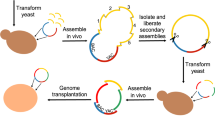Abstract
Digital organisms are computer programs that self-replicate, mutate and adapt by natural selection1,2,3. They offer an opportunity to test generalizations about living systems that may extend beyond the organic life that biologists usually study. Here we have generated two classes of digital organism: simple programs selected solely for rapid replication, and complex programs selected to perform mathematical operations that accelerate replication through a set of defined ‘metabolic’ rewards. To examine the differences in their genetic architecture, we introduced millions of single and multiple mutations into each organism and measured the effects on the organism's fitness. The complex organisms are more robust than the simple ones with respect to the average effects of single mutations. Interactions among mutations are common and usually yield higher fitness than predicted from the component mutations assuming multiplicative effects; such interactions are especially important in the complex organisms. Frequent interactions among mutations have also been seen in bacteria, fungi and fruitflies4,5,6. Our findings support the view that interactions are a general feature of genetic systems7,8,9.
This is a preview of subscription content, access via your institution
Access options
Subscribe to this journal
Receive 51 print issues and online access
$199.00 per year
only $3.90 per issue
Buy this article
- Purchase on Springer Link
- Instant access to full article PDF
Prices may be subject to local taxes which are calculated during checkout



Similar content being viewed by others
References
Ray, T. S. in Artificial Life II (eds Langton, C. G., Taylor, C., Farmer, J. D. & Rasmussen, S.) 371–408 (Addison-Wesley, Redwood City, California, 1991).
Adami, C. Learning and complexity in genetic auto-adaptive systems. Physica D 80, 154–170 (1995).
Adami, C. Introduction to Artificial Life (Springer, New York, 1998).
Elena, S. F. & Lenski, R. E. Test of synergistic interactions among deleterious mutations in bacteria. Nature 390, 395–398 (1997).
De Visser, J. A. G. M., Hoekstra, R. F. & van den Ende, H. Test of interaction between genetic markers that affect fitness in Aspergillus niger. Evolution 51, 1499–1505 (1997).
Clark, A. G. & Wang, L. Epistasis in measured genotypes: Drosophila P-element insertions. Genetics 147, 157–163 (1997).
Wright, S. Evolution and the Genetics of Populations (Univ. Chicago Press, 1977).
Kauffman, S. & Levin, S. Towards a general theory of adaptive walks on rugged landscapes. J. Theor. Biol. 128, 11–45 (1987).
Kauffman, S. A. The Origins of Order (Oxford Univ. Press, New York, 1993).
Paquin, C. & Adams, J. Relative fitness can decrease in evolving populations of S. cerevisiae. Nature 306, 368–371 (1983).
Dykhuizen, D. E., Dean, A. M. & Hartl, D. L. Metabolic flux and fitness. Genetics 115, 25–31 (1987).
Lenski, R. E. & Travisano, M. Dynamics of adaptation and diversification: a 10,000-generation experiment with bacterial populations. Proc. Natl Acad. Sci. USA 91, 6808–6814 (1994).
Rosenzweig, R. F., Sharp, R. R., Treeves, D. S. & Adams, J. Microbial evolution in a simple unstructured environment: genetic differentiation in Escherichia coli. Genetics 137, 903–917 (1994).
Travisano, M., Mongold, J. A., Bennett, A. F. & Lenski, R. E. Experimental tests of the roles of adaptation, chance, and history in evolution. Science 267, 87–90 (1995).
Rainey, P. B. & Travisano, M. Adaptive radiation in a heterogeneous environment. Nature 394, 69–72 (1998).
Burch, C. L. & Chao, L. Evolution by small steps and rugged landscapes in the RNA virus φ6. Genetics 151, 921–927 (1999).
De Visser, J. A., Zeyl, C. W., Gerrish, P. J., Blanchard, J. L. & Lenski, R. E. Diminishing returns from mutation supply rate in asexual populations. Science 283, 404–406 (1999).
Turner, P. E. & Chao, L. Prisoner's dilemma in an RNA virus. Nature 398, 441–443 (1999).
Maynard Smith, J. Byte-sized evolution. Nature 335, 772–773 (1992).
Holland, J. H. Adaptation in Natural and Artificial Systems (MIT Press, Cambridge, Masachusetts, 1992).
Koza, J. R. Genetic Programming (MIT Press, Cambridge, Massachusetts, 1992).
Frank, S. A. in Adaptation (eds Rose, M. R. & Lauder, G. V.) 451–505 (Academic, New York, 1996).
Koza, J. R., Bennett, F. H., Andre, D. & Keane, M. A. in Evolutionary Robotics (ed. Gomi, T.) 37–76 (AAI Press, Kanata, Canada, 1998).
Maynard Smith, J. The Evolution of Sex (Cambridge Univ. Press, 1978).
Kondrashov, A. S. Deleterious mutations and the evolution of sexual reproduction. Nature 336, 435–440 (1988).
Hurst, L. D. & Peck, J. R. Recent advances in understanding of the evolution and maintenance of sex. Trends Ecol. Evol. 11, 46–52 (1996).
Otto, S. P. & Feldman, M. W. Deleterious mutations, variable epistatic interactions, and the evolution of recombination. Theor. Popul. Biol. 51, 134–147 (1997).
Eyre-Walker, A. & Keightley, P. D. High genomic deleterious mutation rates in hominids. Nature 397, 344–347 (1999).
Sokal, R. R. & Rohlf, F. J. Biometry 3rd edn (Freeman, New York, 1994).
Acknowledgements
We thank A. De Visser, S. Elena, D. Lenski, P. Moore, A. Moya and S. Remold for comments, discussion and technical assistance. Access to a Beowulf system was provided by the Center for Advanced Computing Research at the California Institute of Technology. This work was supported by an NSF grant to C.A. and a fellowship from the MacArthur Foundation to R.E.L.
Author information
Authors and Affiliations
Corresponding authors
Rights and permissions
About this article
Cite this article
Lenski, R., Ofria, C., Collier, T. et al. Genome complexity, robustness and genetic interactions in digital organisms. Nature 400, 661–664 (1999). https://doi.org/10.1038/23245
Received:
Accepted:
Issue Date:
DOI: https://doi.org/10.1038/23245
This article is cited by
-
Ontology for the Avida digital evolution platform
Scientific Data (2023)
-
A biological perspective on evolutionary computation
Nature Machine Intelligence (2021)
-
Strong Emergence in Biological Systems: Is It Open to Mathematical Reasoning?
Acta Biotheoretica (2021)
-
Evolution of drift robustness in small populations
Nature Communications (2017)
-
Evolution of Genome Size in Asexual Digital Organisms
Scientific Reports (2016)
Comments
By submitting a comment you agree to abide by our Terms and Community Guidelines. If you find something abusive or that does not comply with our terms or guidelines please flag it as inappropriate.



